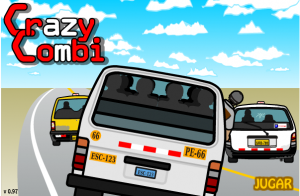Making Games in Peru, 2: Finding a Place in the Global Industry
As recently as a decade ago, one would have been hard pressed to say there’d be a promising future for the gaming industry in Peru, or elsewhere in Latin America. Success stories were short lived, and post mortems would routinely refer to underlying factors such as widespread piracy throughout the region as impeding any sustained growth or innovation. Without significant local audiences to buy and play locally developed games, the prospects for emerging communities of hackers and tinkerers, who were learning how to make games through various forms of reverse engineering, were grim. Some research even suggested that the only possible future for a games industry in Latin America given conditions at the time would be assembling consoles in the cheap labour-driven model of so-called “free trade zones”.
Then in 2003, Steam happened.
It would be a stretch to say that everything changed all of a sudden, but digital distribution did reconfigure what it meant to sell games, and especially who they were being sold to. Up until then, game production was seen more as a local reproduction of an industry that was happening elsewhere , but otherwise relatively independent – distribution and circulation being costly, the chances of local developments having an impact on a global industry were slim. Steam, Valve Software’s digital distribution platform for games, made it possible for game creators to reach far wider audiences which were no longer geographically bound. Even if it wasn’t an immediately accessible possibility for game studios and independent developers outside the U.S., it was already hinting at an entirely different model: the possibility of thinking beyond the local market, and of distributing games to global audiences at very little cost. The prospects offered by digital distribution would only grow stronger as new platforms emerged in later years, especially those tied to mobile platforms and devices, which made it very simple for users to find, purchase and download applications and games to their phones and tablets.
Games could now be made that could potentially be played by gamers all over the world. At least in theory, this made games potentially viable economically for game creators in markets such as Peru, no longer constrained by the size of their local audience – digital distribution made the “long tail” of games, as Wired’s Chris Anderson would describe it, a potential business opportunity. But at the same time, it posed new creative challenges the industry would have to adapt to: what does it mean to make games for a global audience? And how does that reconfigure the identities of local creators?

The Peruvian gaming scene has been adapting to these challenges ever since, as it struggles to define itself and its position in a global industry. An ongoing source of discussion for the game development community has been where to draw sources of inspiration from. Many game creators believe there’s a lot of potential for games based in Peruvian history and culture, such as games set in the Inca Empire, games set in colonial times, games with an Amazon rainforest theme, games based on everyday occurrences, and so on. As other creative industries with a heavy cultural focus expand, such as tourism or gastronomy, games can benefit from existing marketing investments and growing global awareness. And with expansive historical, cultural and geographical diversity to explore, the possibilities for this sort of games have barely begun to be explored.
However, a second camp disagrees, seeing this focus on heavily “localised” games as a form of typecasting. Some developers I’ve talked to who don’t share the interest on branding games as cultural products are concerned this practice could quickly become the distinguising factor for the industry as a whole, leaving little room for people wanting to do something different. Some go even further still and consider heavy localisation as a crutch for the industry and a trend to go for the “low hanging fruit”, rather than maturing as an industry and focusing on broader, more “universal” themes. As the larger share of the industry works on a service model of developing games for third parties, typecasting the local industry too narrowly could harm the potential for many outlets to land client work.
The identity of the Peruvian game development community oscillates around this axis: given the prospect of reaching global audiences, creators are confronted with the challenge of situating themselves as culturally local, or attempting to reach for that abstractly universal framing. It is not that one is necessarily better than the other, but rather that the tension itself is illustrative of how game creation can become culturally dislocated, with local creators finding their way and place in a global set of practices. Just as the local industry emerged out of experiments in reverse engineering the technical side of game creation, its ongoing evolution can be understood in terms of further experiments – some successful, most not so much so – in reverse engineering the formulas and practices to “make it big” in an increasingly crowded and diverse global industry.
